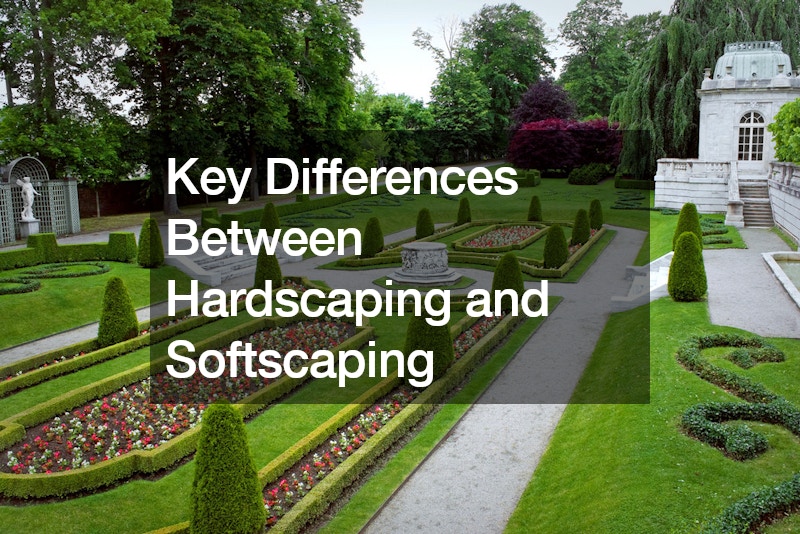Creating a beautiful and functional landscape involves a delicate balance of various elements, primarily categorized into hardscaping and softscaping. Both aspects play essential roles in the overall design and usability of outdoor spaces, yet they differ significantly in their characteristics and purposes. Understanding the key differences between hardscaping and softscaping is crucial for achieving a harmonious and effective landscape design.
Hardscaping: The Structural Backbone
Hardscaping refers to the non-living elements of a landscape. This includes the construction of various structures and features that add functionality, durability, and aesthetic appeal to an outdoor space.
Common hardscaping elements include patios, walkways, retaining walls, water features, decks, and outdoor kitchens.
Key Characteristics of Hardscaping:
Durability: Hardscaping elements are typically built from materials like stone, concrete, brick, wood, and metal, which are designed to withstand weather and wear over time. These materials provide a stable and long-lasting foundation for any landscape.
Functionality: Hardscaping structures serve practical purposes such as providing pathways, creating seating areas, supporting slopes with retaining walls, and enhancing property boundaries. They help in defining the layout and flow of an outdoor space.
Low Maintenance: Once installed, hardscaping requires minimal maintenance compared to softscaping. Regular cleaning and occasional sealing or repairs are usually sufficient to keep hardscaping elements in good condition.
Design Flexibility: Hardscaping offers a wide range of design options and can be tailored to fit various architectural styles and personal preferences. From modern minimalist patios to rustic stone walls, the possibilities are extensive.
Role of Hardscaping Companies: Professional hardscaping companies specialize in designing and installing these structural elements. Their expertise ensures that hardscaping features are not only aesthetically pleasing but also structurally sound and properly integrated with the overall landscape design.
Softscaping: The Living Canvas
Softscaping, on the other hand, encompasses all the living elements of a landscape. This includes plants, trees, shrubs, flowers, lawns, and other horticultural components that bring color, texture, and life to an outdoor space.
Key Characteristics of Softscaping:
Aesthetic Appeal: Softscaping adds natural beauty and visual interest through the use of various plant species, colors, and textures. It creates a dynamic and evolving landscape that changes with the seasons.
Environmental Benefits: Plants in softscaping contribute to the environment by improving air quality, providing shade, reducing soil erosion, and supporting wildlife habitats. They play a vital role in creating a sustainable and eco-friendly landscape.
Maintenance Requirements: Unlike hardscaping, softscaping requires regular maintenance such as watering, pruning, fertilizing, and pest control. The level of maintenance depends on the types of plants and the design of the landscape.
Flexibility and Adaptability: Softscaping allows for continuous adaptation and change. Plants can be replaced, rearranged, or added to enhance the landscape as needed. This flexibility helps in keeping the landscape vibrant and responsive to changing tastes and environmental conditions.
Integrating Hardscaping and Softscaping
A well-designed landscape seamlessly integrates hardscaping and softscaping elements to create a cohesive and functional outdoor space. Hardscaping provides the structural framework, while softscaping adds the natural beauty and environmental benefits. Effective landscape design considers the interplay between these elements, ensuring that they complement each other and enhance the overall aesthetic and usability of the space.
For instance, a patio (hardscaping) can be softened with surrounding flower beds and shrubs (softscaping), creating a welcoming and balanced environment. Similarly, a garden path (hardscaping) can be lined with trees and perennials (softscaping) to guide the eye and enhance the natural appeal.
Conclusion
Understanding the key differences between hardscaping and softscaping is essential for achieving a successful landscape design. While hardscaping provides the structural backbone and functionality, softscaping adds life, beauty, and environmental benefits. By integrating these elements thoughtfully, homeowners can create outdoor spaces that are both beautiful and practical, reflecting their personal style and enhancing their quality of life. Professional hardscaping companies play a crucial role in bringing these designs to life, ensuring that each element is expertly crafted and seamlessly integrated.
.

